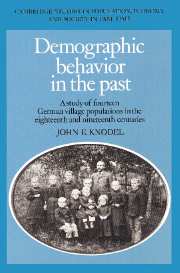 Demographic Behavior in the Past
Demographic Behavior in the Past Published online by Cambridge University Press: 04 August 2010
The decline in fertility associated with the demographic transition has been characterized as a shift from a system in which reproduction was largely controlled through social institutions and customs to a system where the private choice of individual couples plays the major role. This shift of control from the societal to the family level involves the emergence and spread of a fundamentally new pattern of reproductive behavior that has been described in the previous chapter as family limitation. In brief, the fertility transition can be viewed as representing the transformation of a population's reproductive pattern from one characterized by natural fertility to one in which family limitation predominates. In this chapter, the nature and extent of marital fertility control in the sample village populations are explored, in the course of which several relevant methodological and substantive issues are addressed.
As described in the previous chapter, at the core of family limitation are attempts to stop childbearing prior to the end of the biologically defined reproductive span. This has implications for both the age at which women terminate childbearing and the age patterns of fertility. The exploration of the shift of natural fertility to family limitation begins by examining indices that utilize these implications for detecting deliberate marital fertility control. In particular, the Coale–Trussell index of fertility control (m) and the age of mothers at last birth are examined in some detail.
To save this book to your Kindle, first ensure [email protected] is added to your Approved Personal Document E-mail List under your Personal Document Settings on the Manage Your Content and Devices page of your Amazon account. Then enter the ‘name’ part of your Kindle email address below. Find out more about saving to your Kindle.
Note you can select to save to either the @free.kindle.com or @kindle.com variations. ‘@free.kindle.com’ emails are free but can only be saved to your device when it is connected to wi-fi. ‘@kindle.com’ emails can be delivered even when you are not connected to wi-fi, but note that service fees apply.
Find out more about the Kindle Personal Document Service.
To save content items to your account, please confirm that you agree to abide by our usage policies. If this is the first time you use this feature, you will be asked to authorise Cambridge Core to connect with your account. Find out more about saving content to Dropbox.
To save content items to your account, please confirm that you agree to abide by our usage policies. If this is the first time you use this feature, you will be asked to authorise Cambridge Core to connect with your account. Find out more about saving content to Google Drive.